[nextpage title=”Introduction”]
This time we tested a new cooler from 3R System: iCEAGE Prima Boss II, new version of iCEAGE Prima Boss we reviewed recently. But will it perform better than its older brother? Check it out!
The box resembles Prima Boss‘, except for the purple pallete and the diamond-shaped clear window at the front.
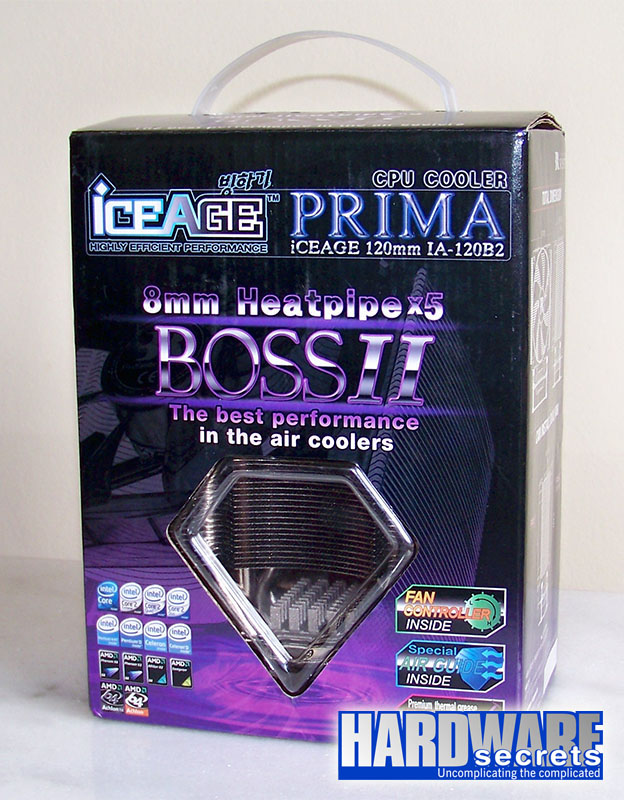 Figure 1: Box.
Figure 1: Box.
In Figure 2 we can see the box contents: heatsink, fan, installation hardware, thermal compound, user manual, fan controller and an air deflector that allows the user to direct part of the airflow to the transistors from the voltage regulator circuit.
In Figure 3 we can see Prima Boss II heatsink. The main difference to the older model is the number of heatpipes: five, against four on the previous model. In both models the heatpipes are 8 mm in diameter.
In the next pages we will see the cooler in details.
[nextpage title=”3R System iCEAGE Prima Boss II”]
In Figure 4 we see the cooler from the front. On the base there is a small aluminum auxiliary heatsink. The heatpipes use an amazing design where they are spread in front of the fan, receiving direct airflow.
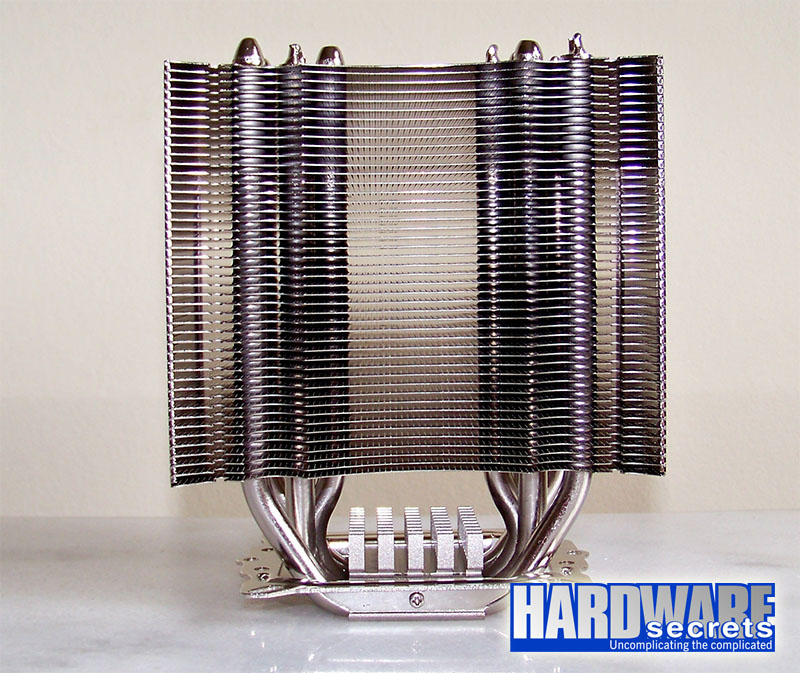 Figure 4: Front view.
Figure 4: Front view.
In Figure 5 we have a side view of Prima Boss II. The sides of the fins are folded, making a closed wall, so the fins create a kind of air tunnel.
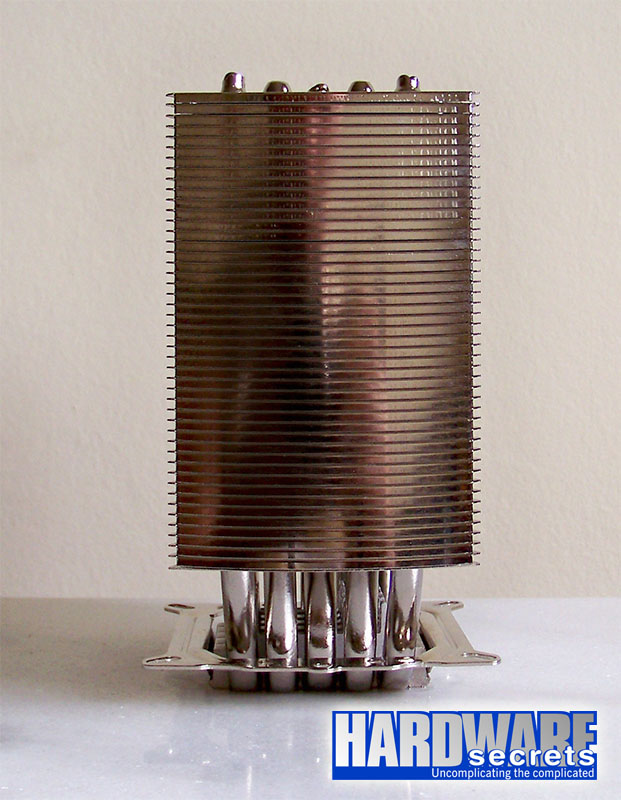 Figure 5: Side view.
Figure 5: Side view.
In Figure 6, you can see Prima Boss II heatsink from above. Note the fin design, the position of the heatpipes and the surface of the top fin, which is not smooth: has small reentrancies. This roughness makes a turbulent airflow near the fins, which helps the heat transfer.
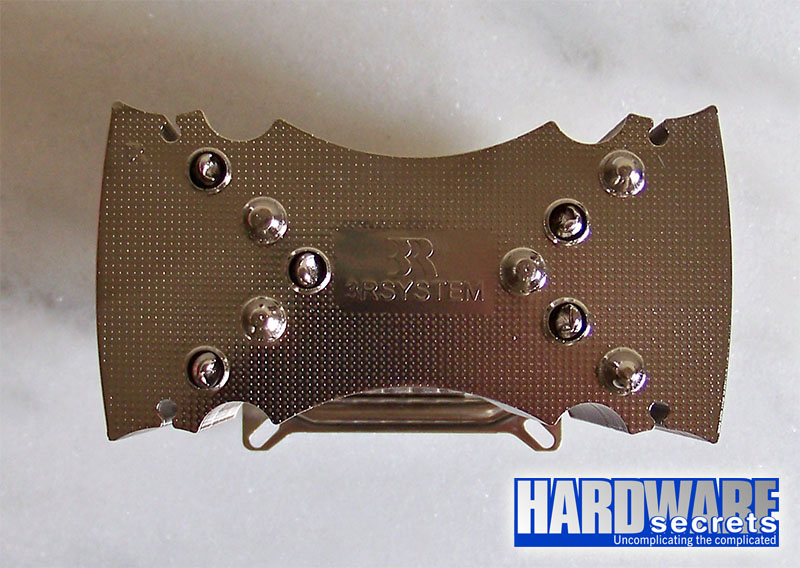 Figure 6: Top view.
Figure 6: Top view.
In Figure 7 we can see the base of the cooler, made practically only by the heatpipes. It is very smooth but has no mirrored looks. We can also see the “iCECREAM V2” thermal compound tube.
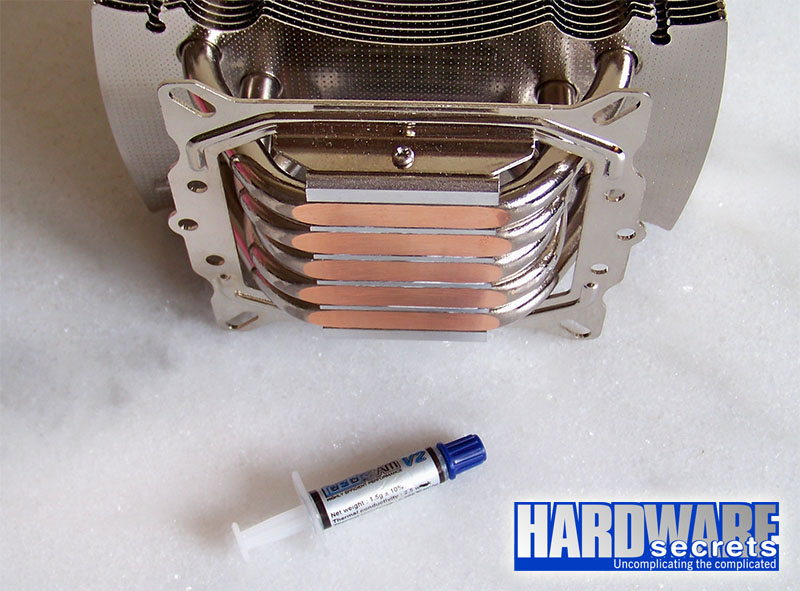 Figure 7: Base.
Figure 7: Base.
[nextpage title=”3R System iCEAGE Prima Boss II (Cont’d)”]
In Figure 8 we can see the 120 mm transparent fan with blue LEDs that comes with the cooler.
[nextpage title=”Installation”]
In order to install Prima Boss II in your system, you first must install a metallic backplate on the solder side of your motherboard, where four (sockets 775, 1156, 1366, AM3, AM2+ and AM2) or two (sockets 939 and 754) screws are attached. After that, you just need to apply thermal compound, put the cooler in place and fasten the spring screws that hold the cooler in place.
 Figure 12: Backplate ready to be installed.
Figure 12: Backplate ready to be installed.
In Figure 13 we can see the cooler installed on our motherboard. It didn’t interfere with the motherboard heatsink, but the fan stayed over the first memory slot, preventing the use of tall memory modules on it.
 Figure 13: Installed on the motherboard.
Figure 13: Installed on the motherboard.
In Figure 14 we can see the cooler installed in our case. The fan glows blue when powered.
 Figure 14: Installed inside the case.
Figure 14: Installed inside the case.
[nextpage title=”How We Tested”]
We are adopting the following methodology for our CPU cooler reviews.
First, we chose the CPU with the highest TDP (Thermal Design Power) we had available, a Core 2 Extreme QX6850, which has a 130 W TDP. The choice for a CPU with a high TDP is obvious. To measure the efficiency of the tested cooler, we need a processor that gets very hot. This CPU works by default at 3.0 GHz, but we overclocked it to 3.33 GHz, in order to heat it as much as possible.
We took noise and temperature measurements with the CPU idle and under full load. In order to achieve 100% CPU load on the four processing cores we ran Prime95 with the “In-place Large FFTs” option, and three instances of the StressCPU program, all at the same time.
We also compared the reviewed cooler to the Intel stock cooler (with copper base), which comes with the processor we used, and also with some other coolers we have tested using the same methodology.
Temperature measurements were taken with a digital thermometer, with the sensor touching the base of the cooler, and also with the core temperature reading (given by the CPU thermal sensor) from the from the SpeedFan program, using an arithmetic average of the four core temperature readings.
The sound pressure level (SPL) was measured with a digital noise meter, with its sensor placed 4″ (10 cm) from the fan. We turned off the video board cooler so it wouldn’t interfere with the results, but this measurement is only for comparative purposes, because a precise SPL measurement needs to be made inside an acoustically insulated room with no other noise sources, which is not the case here.
Hardware Configuration
- Processor: Core 2 Extreme QX6850
- Motherboard: Gigabyte EP45-UD3L
- Memory: 2 GB Corsair XMS2 DHX TWIN2X2048-6400C4DHX G (DDR2-800/PC2-6400 with timings 4-4-4-12), running at 800 MHz
- Hard drive: 1 TB Seagate Barracuda 7200.12 (ST31000528AS, SATA-300, 7200 rpm, 32 MB buffer)
- Video card: PNY Verto Geforce 9600 GT
- Video resolution: 1680×1050
- Video monitor: Samsung Syncmaster 2232BW Plus
- Power supply required: Seventeam ST-550P-AM
- Case: 3RSystem K100
Software Configuration
- Windows 7 Home Premium 64 bit
Software Used
Error Margin
We adopted a 2 °C error margin, i.e., temperature differences below 2 °C are considered irrelevant.
[nextpage title=”Our Tests”]
On the tables below you can see our results. We ran the same tests with the coolers shown on below tables. Each test ran with the CPU idle and the with the CPU fully loaded. On BigTyp 14Pro, TMG IA1, NH-U12P and ISGC-300 the tests were done with the fan at full speed and at minimum speed. The other coolers were connected directly to the motherboard and it controls the fan speed based on CPU load level and temperature on PWM models. ISGC-400, iCEAGE Prima Boss and Megahalems Rev. B were tested at minimum speed on idle test and at maximum speed on full load test.
|
CPU Idle |
|||||
| Cooler | Room Temp. | Noise | Fan Speed | Base Temp. | Core Temp. |
| Intel stock | 14 °C | 44 dBA | 1000 rpm | 31 °C | 42 °C |
| BigTyp 14Pro (min) | 17 °C | 47 dBA | 880 rpm | 29 °C | 36 °C |
| BigTyp 14Pro (max) | 17 °C | 59 dBA | 1500 rpm | 26 °C | 34 °C |
| Akasa Nero | 18 °C | 41 dBA | 500 rpm | 26 °C | 35 °C |
| Cooler Master V10 | 14 °C | 44 dBA | 1200 rpm | 21 °C | 26 °C |
| TMG IA1 (max) | 16 °C | 47 dBA | 1500 rpm | 22 °C | 30 °C |
| TMG IA1 (min) | 16 °C | 57 dBA | 2250 rpm | 21 °C | 30 °C |
| Zalman CNPS10X Extreme | 16 °C | 44 dBA | 1200 rpm | 21 °C | 29 °C |
| Thermaltake ISGC-100 | 18 °C | 44 dBA | 1450 rpm | 35 °C | 49 °C |
| Noctua NH-U12P (low) | 15 °C | 42 dBA | 1000 rpm | 20 °C | 30 °C |
| Noctua NH-U12P | 15 °C | 46 dBA | 1400 rpm | 20 °C | 28 °C |
| Noctua NH-C12P | 17 °C | 46 dBA | 1400 rpm | 23 °C | 28 °C |
| Thermaltake ISGC-200 | 21 °C | 43 dBA | 1100 rpm | 31 °C | 35 °C |
| Schythe Kabuto | 22 °C | 42 dBA | 800 rpm | 29 °C | 34 °C |
| Arctic Cooling Alpine 11 Pro | 20 °C | 43 dBA | 1500 rpm | 32 °C | 39 °C |
| ISGC-300 (min) | 18 °C | 42 dBA | 800 rpm | 26 °C | 30 °C |
| ISGC-300 (max) | 18 °C | 46 dBA | 1400 rpm | 24 °C | 26 °C |
| SilverStone NT06-E | 21 °C | 66 dBA | 2600 rpm | 30 °C | 41 °C |
| Zalman CNPS9700 NT | 22 °C | 48 dBA | 1700 rpm | 28 °C | 35 °C |
| Scythe Mugen-2 | 17 °C | 41 dBA | 700 rpm | 25 °C | 30 °C |
| ISGC-400 (min) | 17 °C | 44 dBA | 850 rpm | 24 °C | 30 °C |
| Cooler Master Vortex 752 | 20 °C | 48 dBA | 1700 rpm | 32 °C | 44 °C |
| iCEAGE Prima Boss (min) | 22 °C | 42 dBA | 1000 rpm | 29 °C | 36 °C |
| Evercool Buffalo | 17 °C | 51 dBA | 1850 rpm | 22 °C | 29 °C |
| Scythe Big Shuriken | 20 °C | 42 dBA | 900 rpm | 31 °C | 39 °C |
| Cooler Master Hyper TX3 | 21 °C | 44 dBA | 1700 rpm | 30 °C | 39 °C |
| Titan Skalli | 20 °C | 43 dBA | 1200 rpm | 27 °C | 34 °C |
| Prolimatech Megahalems Rev. B | 21 °C | 40 dBA | 800 rpm | 28 °C | 32 °C |
| Zalman CNPS9900 NT | 23 °C | 45 dBA | 900 rpm | 30 °C | 34 °C |
| Cooler Master Hyper N620 | 21 °C | 44 dBA | 1200 rpm | 28 °C | 34 °C |
| Nexus LOW-7000 R2 | 23 °C | 46 dBA | 1400 rpm | 33 °C | 42 °C |
| Evercool HPK-10025EA | 20 °C | 54 dBA | 1900 rpm | 27 °C | 34 °C |
| Evercool HPH-9525EA | 23 °C | 50 dBA | 1900 rpm | 38 °C | 49 °C |
| iCEAGE Prima Boss II | 23 °C | 42 dBA | 1000 rpm | 29 °C | 35 °C |
|
CPU Fully Loaded |
|||||
| Cooler | Room Temp. | Noise | Fan Speed | Base Temp. | Core Temp. |
| Intel stock | 14 °C | 48 dBA | 1740 rpm | 42 °C | 100 °C |
| BigTyp 14Pro (min) | 17 °C | 47 dBA | 880 rpm | 43 °C | 77 °C |
| BigTyp 14Pro (max) | 17 °C | 59 dBA | 1500 rpm | 35 °C | 70 °C |
| Akasa Nero | 18 °C | 48 dBA | 1500 rpm | 34 °C | 68 °C |
| Cooler Master V10 | 14 °C | 54 dBA | 1900 rpm | 24 °C | 52 °C |
| TMG IA1 (max) | 16 °C | 47 dBA | 1500 rpm | 27 °C | 63 °C |
| TMG IA1 (min) | 16 °C | 57 dBA | 2250 rpm | 25 °C | 60 °C |
| Zalman CNPS10X Extreme | 16 °C | 51 dBA | 1900 rpm | 24 °C | 50 °C |
| Thermaltake ISG-100 | 18 °C | 50 dBA | 1800 rpm | 58 °C | 93 °C |
| Noctua NH-U12P (low) | 15 °C | 42 dBA | 1000 rpm | 28 °C | 59 °C |
| Noctua NH-U12P | 15 °C | 46 dBA | 1400 rpm | 25 °C | 54 °C |
| Noctua NH-C12P | 17 °C | 46 dBA | 1400 rpm | 37 °C | 76 °C |
| Thermaltake ISGC-200 | 21 °C | 48 dBA | 1900 rpm | 42 °C | 68 °C |
| Scythe Kabuto | 22 °C | 47 dBA | 1200 rpm | 38 °C | 63 °C |
| Arctic Cooling Alpine 11 Pro | 20 °C | 51 dBA | 2300 rpm | 49 °C | 85 °C |
| ISGC-300 (min) | 18 °C | 42 dBA | 800 rpm | 36 °C | 64 °C |
| ISGC-300 (max) | 18 °C | 46 dBA | 1400 rpm | 31 °C | 56 °C |
| SilverStone NT06-E | 21 °C | 66 dBA | 2600 rpm | 39 °C | 96 °C |
| Zalman CNPS9700 NT | 22 °C | 56 dBA | 2600 rpm | 34 °C | 63 °C |
| Scythe Mugen-2 | 17 °C | 46 dBA | 1300 rpm | 28 °C | 54 °C |
| ISGC-400 (max) | 17 °C | 47 dBA | 1400 rpm | 36 °C | 69 °C |
| Cooler Master Vortex 752 | 20 °C | 55 dBA | 2300 rpm | 48 °C | 92 °C |
| iCEAGE Prima Boss (max) | 22 °C | 53 dBA | 2000 rpm | 35 °C | 59 °C |
| Evercool Buffalo | 17 °C | 51 dBA | 1850 rpm | 32 °C | 67 °C |
| Scythe Big Shuriken | 20 °C | 50 dBA | 1500 rpm | 51 °C | 85 °C |
| Cooler Master Hyper TX3 | 21 °C | 53 dBA | 2700 rpm | 39 °C | 66 °C |
| Titan Skalli | 20 °C | 47 dBA | 1550 rpm | 37 °C | 69 °C |
| Prolimatech Megahalems Rev. B | 21 °C | 61 dBA | 2600 rpm | 30 °C | 51 °C |
| Zalman CNPS9900 NT | 23 °C | 56 dBA | 2000 rpm | 34 °C | 54 °C |
| Cooler Master Hyper N620 | 21 °C | 50 dBA | 1650 rpm | 32 °C | 56 °C |
| Nexus LOW-7000 R2 | 23 °C | 53 dBA | 1900 rpm | 45 °C | 74 °C |
| Evercool HPK-10025EA | 20 °C | 54 dBA | 1900 rpm | 39 °C | 69 °C |
| Evercool HPH-9525EA | 23 °C | 50 dBA | 1900 rpm | 58 °C | 100 °C |
| iCEAGE Prima Boss II | 23 °C | 56 dBA | 2100 rpm | 32 °C | 56 °C |
The next graph shows how many degrees Celsius the CPU core was hotter than room temperature during our idle tests.
The next graph gives you an idea on how many degrees Celsius the CPU core was hotter than room temperature during our full load tests.
[nextpage title=”Main Specifications”]
3R System iCEAGE Prima Boss II main features are:
- Application: Socket LGA775, 1156, 1366, AM3, AM2+, AM2, 940, 939 and 754 processors.
- Fins: Aluminum.
- Base: Aluminum, with heatpipes in direct contact with the CPU.
- Heat-pipes: Five U-shape 8-mm copper heat-pipes.
- Fan: 120 mm.
- Nominal fan speed: 2,000 rpm.
- Fan air flow: 78.5 cfm.
- Maximum power consumption: 4.56 W.
- Nominal noise level: 32 dBA.
- Weight: 1.61 lbs (730 g).
- More information: https://www.3rsys.com
- Average price in the US: This cooler is not sold in the US yet.
[nextpage title=”Conclusions”]
When we tested iCEAGE Prima Boss a couple of months ago we were impressed with its performance. So, when we received this new model, we thought it would not overperform the previous model. Well, we were wrong.
The changes were not substantial, with the addition of one extra heatpipe and a new fin design, but the performance was improved of about 4°C in out tests. The noise level is still good and the installation is simple and steady. Other advantage of this model is the support for sockets 1156 and 1366.
We still do not know how much Prima Boss II will cost, but if the price is equivalent to its predecessor’s, it will surely be a good buy.
3R System iCEAGE Prima Boss II is one of the world’s top performer in today’s CPU coolers market. Due to its great performance, it receives the Hardware Secrets Golden Award seal.









Leave a Reply